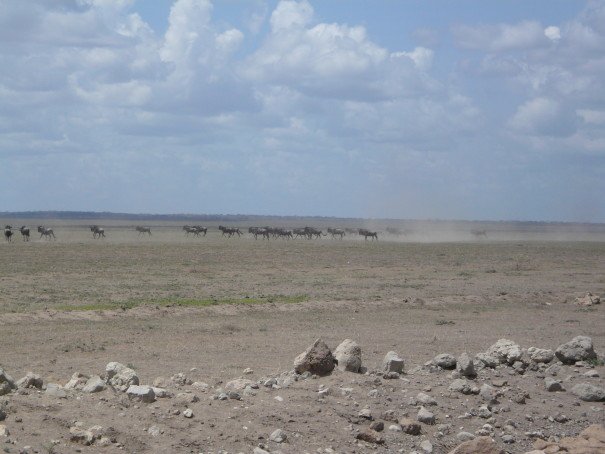
Agreed, Being a Wildebeest Would Totally Suck

Agreed, Being a Wildebeest Would Totally Suck
Kilimanjaro Beer on the Serengeti
In Tanzania, this is what is known as an “African massage.” It’s my third day of being launched side to side like a pinball in a Toyota Land Cruiser as we bounce and rock over rutted roads in the Serengeti. We stop not once, but twice, to change shredded tires.
The pop-up roof affords me an elevated, wide-angle view of the savannah and the incredible wildlife. There’s beauty, of course. Sleek lions prowling through tall grasses, golden in the warm early morning light. A sinewy leopard lazing on a rock. Impalas and gazelles bounding over the dry terrain, as if propelled on bionic legs.
But there is this, too. Opportunistic hyenas sitting alertly, watching and waiting. Three dozen zebras drinking from a shallow stream, suddenly bolting en masse, terrified when a stealthy lioness appears nearby. A baby zebra near the road, its flesh devoured except from its head. A bloated wildebeest, a gaping hole in its chest.
I’ve become fond of wildebeests. They look comical with their spindly legs, horse-like manes and tails, big chests and small hindquarters, but they are fast, sure-footed, and resolute in their relentless migration to water. Some have an endearing habit of making direct eye contact with us as if trying to figure out what we are.
We see hundreds upon hundreds of them galloping toward a stream trickling through the parched grasslands. The youngest are about four months old, gamely keeping up with the herd. One mom pauses 15 seconds to let her youngster nurse in the midst of the stampede.
It’s a hazardous journey. Lions and hyenas lie in wait on land, and crocodiles in the water. We see one wildebeest separated miles from its herd. It surely is doomed. Only a half hour earlier we had seen lions in the vicinity.
Late in the afternoon, we spot two scrums of vultures digging into dead wildebeests. The second carcass is near the road. We stop and watch. A dozen of the beady-eyed birds with tiny heads and long necks tear into its belly and into each other. Squabbling loudly, they flap their wings and attack each other whenever one snatches a coveted strand of guts. It’s a sordid end for the hapless wildebeest, ripped into and fought over, its paltry remains left to rot in the remorseless sun.
Two of the vultures, however, stand quietly to the side, throats bloodied in the feeding frenzy. If their wounds fester, their fate will soon be that of the wildebeest in the harsh cycle of life and death in the Serengeti.
We drive back to our lodge after a long and dusty day. I head to the bar. It has a wide patio with a small shimmering swimming pool perched above the expansive plains below.
I quaff a Kilimanjaro beer and ponder the dichotomy: Endless undulating grasses, dramatic acacia trees and charismatic wildlife on one hand; the undercurrent of fear and ferocity on the other. Tormented by tsetse flies and ticks, the Serengeti’s inhabitants constantly are prowling for prey, constantly wary of becoming prey.
I have no such worries. Nor do I have any epiphanies. Only this: thank goodness I’m not a wildebeest. Then I order another Kilimanjaro.